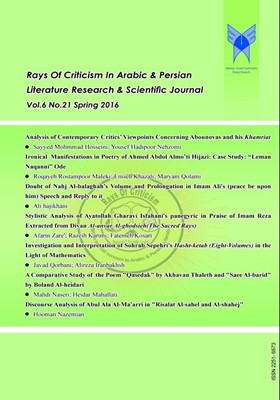-
-
List of Articles
-
Open Access Article
1 - Analysis of Contemporary Critics’ Viewpoints Concerning Abounovas and his Khamriat
Sayyed Mohmmad Hosseini Yousef Hadipoor Nehzomi -
Open Access Article
2 - Ironical Manifestations in Poetry of Ahmed Abdol Almo’ti Hijazi : Case Study: “Leman Naqanni” Ode
Roqayeh Rostampoor Maleki Ensieh Khazali Maryam Qolami -
Open Access Article
3 - Doubt of Nahj Al-balaghah’s Volume and Prolongation in Imam Ali's (peace be upon him) Speech and Reply to it
Ali hajikhani -
Open Access Article
4 - Stylistic Analysis of Ayatollah Gheravi Isfahani's panegyric in Praise of Imam Reza Extracted from Divan Al-anvar Al-ghodsieh(The Sacred Rays)
Afarin Zare' Razeih Karimi Fatemeh Kosari -
Open Access Article
5 - Investigation and Interpretation of Sohrab Sepehri's Hasht-ketab(Eight-Volumes) in the Light of Mathematics
Javad Qorbani Alireza Iranbakhsh -
Open Access Article
6 - A Comparative Study of the Poem "Qasedak" by Akhavan Thaleth and "Saee Al-barid" by Boland Al-heidari
Heidar Mahallati Mahdi Naseri -
Open Access Article
7 - Discourse Analysis of Abul Ala Al-Ma'arri in "Risalat Al-sahel and Al-shahej"
Hooman Nazemian
-
The rights to this website are owned by the Raimag Press Management System.
Copyright © 2021-2025







